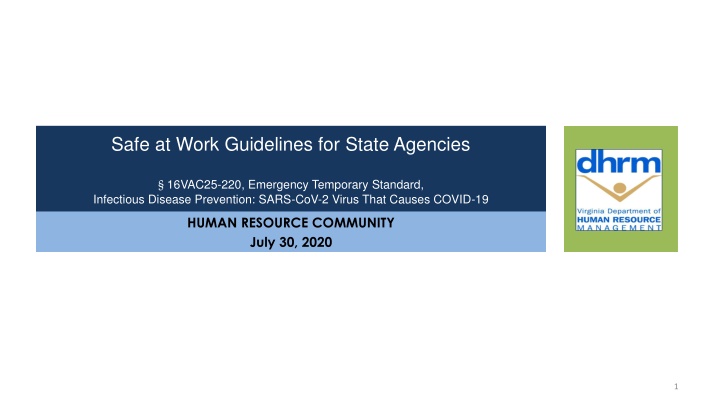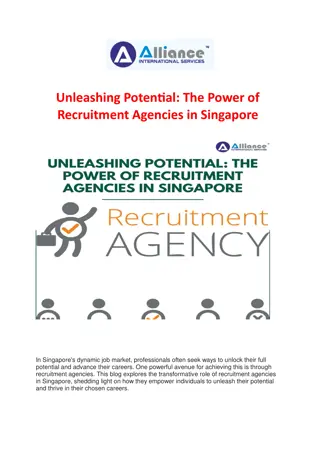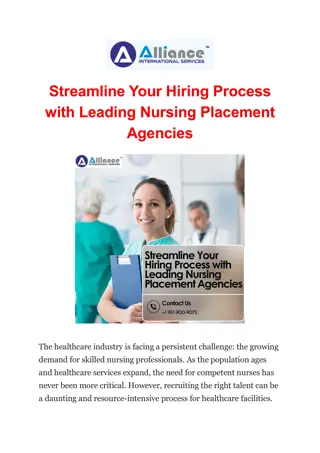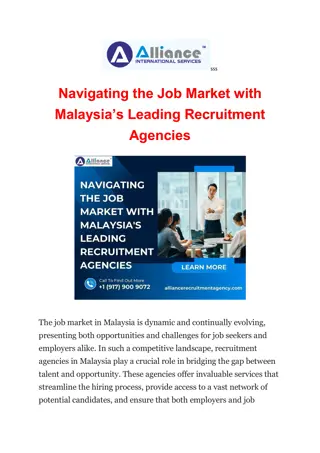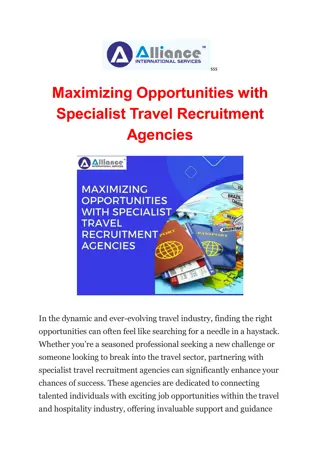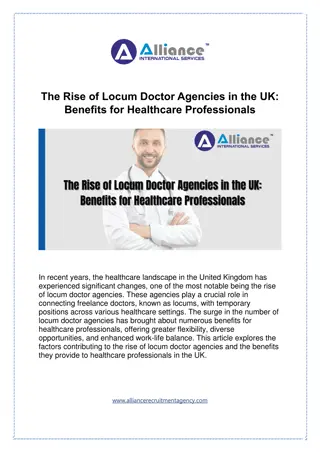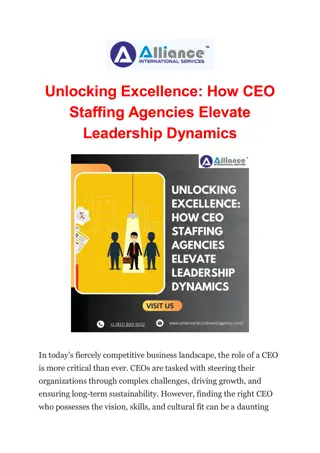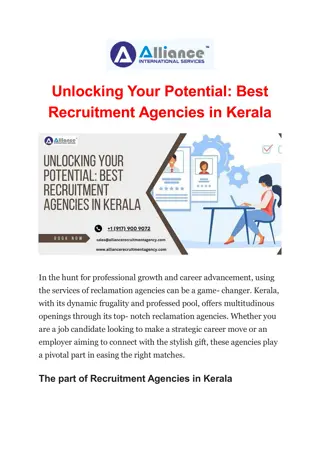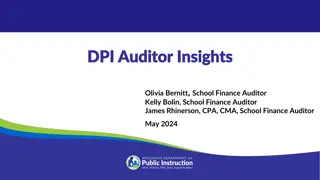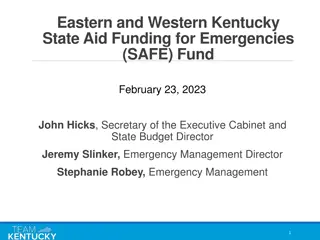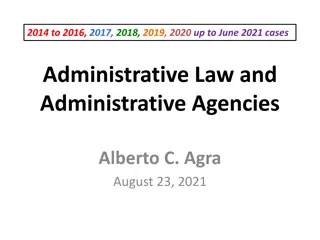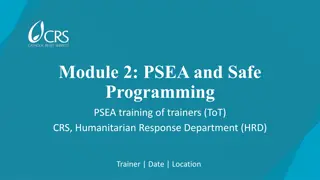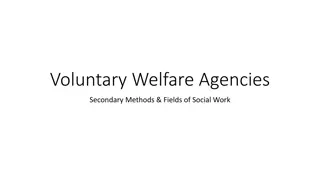Safe at Work Guidelines for State Agencies
Guidelines and resources for state agencies regarding the prevention of COVID-19. Covers hazard assessment, response planning, training requirements, and agency roles.
Download Presentation

Please find below an Image/Link to download the presentation.
The content on the website is provided AS IS for your information and personal use only. It may not be sold, licensed, or shared on other websites without obtaining consent from the author.If you encounter any issues during the download, it is possible that the publisher has removed the file from their server.
You are allowed to download the files provided on this website for personal or commercial use, subject to the condition that they are used lawfully. All files are the property of their respective owners.
The content on the website is provided AS IS for your information and personal use only. It may not be sold, licensed, or shared on other websites without obtaining consent from the author.
E N D
Presentation Transcript
Safe at Work Guidelines for State Agencies 16VAC25-220, Emergency Temporary Standard, Infectious Disease Prevention: SARS-CoV-2 Virus That Causes COVID-19 HUMAN RESOURCE COMMUNITY July 30, 2020 1
HRCS Webinar Series Educate Inform Inspire 2
AGENDA To provide an overview of the requirements established in 16VAC25-220, Emergency Temporary Standard for COVID19 Conducting a Hazard Identification Assessment; Developing your Agency s Infectious Disease Preparedness and Response Plan; Reviewing obligations for worker training and communication. Program is non-specific to agency business needs and focused on workplaces with lower to medium hazards/risks. 3
RESOURCES Virginia Department of Labor and Industry - COVID-19 Resources 16VAC25-220 Emergency Temporary Standard Infectious Disease Prevention: SARS-CoV-2 Virus That Causes COVID-19 (July 15, 2020) COVID19 Safe at Work Guidance for Agency Leaders (dated May 13th) Safe at Work Guidance Addendum (dated May 27th) Executive Order 63 OSHA Guidance on Preparing Workplaces for COVID19 The Virginia Department of Labor and Industry s Virginia Occupational Safety and Health (VOSH) and their Consultative Services programs are subject matter experts related to this material and will provide assistance via the guidance documents posted on their website and are available for questions. 4
Agency Roles & Responsibilities Agency Roles Responsibilities Executive Leadership Ensure Agency is compliant with 16VAC25-220 requirements. Fully support all safety/health initiatives to include employee communications and listen/respond to employees safety concerns. Human Resources In partnership: conduct facility hazard and risk assessments; develop Infectious Disease Preparation & Response Plan; Identify or create, and communicate informational materials or training related to mitigating exposures and risks related to COVID19; Listen and respond to employees safety concerns. Partner with Agency HR and Workforce Safety/Health Officer to manage environmental controls within the facility to mitigate/eliminate risks and hazards. Guide, coach and advise employees on safe at work requirements; Consult with HR for issues of non-compliance or medical related concerns that impact compliance; Lead by example and follow all safety/health requirements. Follow the Agency s safety/health initiatives; Communicate with manager/supervisors if they are unable to comply; Notify managers/supervisors if positive or suspected positive for COVID19 Workforce Safety/Health Officer Facilities Manager (DGS, Internal or Leased) Managers and Supervisors Employees 5
16VAC25-220 Purpose, Scope & Applicability CONTROL PREVENT MITIGATE Risk of Exposure 6
Hazard Identification & Assessment Personal Protection Equipment Workspace Administrative Engineering 7
Organizational and Job Risk Assessments Assess overall risks: Assess job duty risks: Very High Work environment factors Workplace interactions Work space factors Egress to/from work space Shared or common areas Increased exposure risks Social distancing risks Training on safe practices while performing higher risk tasks Federal OSHA publication 3990 breaks this down further by job tasks specific to COVID-19 High Medium Low 8
NIOSH Hierarchy of Controls The National Institute for Occupational Safety and Health or NIOSH leads a national initiative called Prevention through Design (PtD) to prevent or reduce occupational injuries, illnesses, and fatalities through the inclusion of prevention considerations in all designs that impact workers. Hierarchy of controls is a PtD strategy. To learn more, visit the PtD website 9
Engineering Risk Assessment & Controls Facility or Office Occupancy Rate Enhanced ventilation rates with clean filters Signage with guidance to Workers, Visitors, Customers Barriers for customer service windows Common spaces (lobby, breakroom, restrooms, meeting rooms) Social distancing markers (tape on the floor, signs, etc.) Increased cleaning/disinfecting schedule with EPA-approved products HR Building Safety and Health Officer Facility Manager Provide supplies (tissues, sanitizing wipes, hand sanitizer, and hands-free trash receptacles) 10
Workspace Administrative Controls Examples to mitigate hazards/risks: Telework where feasible Increased breaks for handwashing Staggered scheduling promote social distancing for spaces with close contact Staggered breaks avoid gatherings in break room areas, smoking areas Provide face coverings, tissues, sanitizing wipes and hand sanitizer (60% alcohol) to employees and customers Be prepared for ADA interactive discussions regarding face coverings, return to work space, etc. and respond in writing to employees. 11
Face Coverings and Other PPE Face Coverings are required in state facilities and must cover both nose and mouth. Medical exceptions with documentation and Interactive Process. Face coverings are not respirators or defined as PPE. Provide face coverings or allow employees to wear their own as business appropriate. Advise employees on proper wear and use to include cleaning of cloth face coverings Glove usage one time use only 12
Temperature Screenings Not required in 16VAC25-220 Employer Choice Permitted by EEOC considered as medical screening Confidential medical record retain 30 years post separation HIPAA Concerns Safety of the Screeners Adequate PPE Staging Area impacts Temperature Readings (breeze, heat, etc.) Impact of Heat Index Training of the Screeners Medical Personnel Preferred 13
COVID-19 Hazard Assessment Evaluator:__________________________Department/Location:_____________________Date:_______________ _ Job Task/Employee/Job Category Check the appropriate box for each hazard: Very High Description of Hazard(s) Engineering/Administrative Controls PPE High Medium Lower Job Task/Employee/Job Category Check the appropriate box for each hazard: Very High Description of Hazard(s) Engineering/Administrative Controls PPE High Medium Lower I certify that the above hazard assessment was performed to the best of my knowledge and ability, based on the hazards present on this date. ______________________________________ (signature) Excerpt of form developed by VOSH at www.doli.virginia.gov 14
Infectious Disease Preparedness & Response Plan Evaluate Risk of Exposure Identify Controls Needed to Mitigate Risks Customers Where? OSHA/VOSH Standards How? Coworkers VDH/CDC Guidelines Non- Worker Exposure To What Extent? Occupational Risk Factors Prepare for contingencies and future outbreaks Visitors Individual Risk Factors 15
Infectious Disease Preparedness & Response Plan VOSH provides a suggested Template some information is sorted by industry. Include a section for Sick Employees & Process for Notifying Management Returning to Work from Suspected or Positive COVID-19 OSHA COVID-19 Recordkeeping Requirements Notification Requirements Training Requirements Anti-discrimination Requirements 16
CDC Updated Symptoms of COVID19 Singular or in Combination: 2 to 14 days after exposure Cough Fever (100.4, warm to touch or feels feverish) Chills Congestion or Runny Nose Muscle Pain or Body Aches (unrelated to physical activity) Sore Throat New loss of smell or taste Fatigue Headache Gastrointestinal discomfort (nausea, vomiting, diarrhea) Shortness of breath or difficulty breathing As of May 13, 2020 The above symptoms should not be attributable to any other medical conditions Person to Person exposure typically means close (within the six foot range) and prolonged or frequent interactions Surface exposures virus may live for hours or minutes depending upon the type of surface. CDC recommends always carry a face covering, 60% Alcohol-based Hand Sanitizer and tissues. Never leave home without it. 17
Pre-Entry Workplace Questionnaire Answer Yes/No Yes No Explanation/Comments Running a fever of 100.4 or feel feverish? Did you take your temperature? Experiencing Chills? Body/Muscle Aches not related to physical activity? Unexplained fatigue? Sore throat not attributable to other condition? Runny nose or congestion not attributable to other condition? Shortness of breath or difficulty breathing? Cough not attributable to other condition? Headache not attributable to other condition? New loss of smell or taste? Recent travel to a high risk area with high levels of COVID19? Please indicate the location. Tested positive or had a recent exposure to an individual testing positive for COVID-19. Please explain. 18
Prompt ID and Isolation of Sick People Critical step for protecting workers, customers and visitors Policy - Stay home and go home if sick For workers: self-monitoring and reporting in if sick Exercise notification procedures if a worker tests positive for COVID19 or other infectious disease OSHA/VOSH Recordability of the Coronavirus 19
16VAC 25-220 RTW Positive/Suspected COVID-19 Workers with or Suspected to have COVID-19 can stop isolation and return to the workplace when they ve met one of the two options: Option1: Symptom Based - Employee will not have a test to determine if they are still contagious. Must meet these three conditions: no fever for at least 72 hours (that is, 3 full days of no fever without the use medicine that reduces fevers) AND other symptoms have improved (for example, cough or shortness of breath have improved) AND at least 10 days have passed since their symptoms first appeared. Option 2: Test-Based to determine if the employee is still contagious. Must meet these three conditions: The employee no longer has a fever (without the use of medicine that reduces fevers) AND other symptoms have improved (for example, cough or shortness of breath have improved) AND they received two negative tests in a row, at least 24 hours apart. Their doctor should follow CDC guidelines. Note: CDC/VDH Guidance may indicate less time is required for returning to work. However, the VOSH Standard requires employers to exercise the practice that provides the greater protection to workers. 20
Training Requirements Required Training Topics Requirements of the standard/regulation Training required within 30 days of publication; 60 days for Infectious Disease Preparation & Response Plan Symptoms of COVID-19 disease and transmission of the virus Safe and healthy work practices (e.g., distancing, sanitizing procedures, etc.) Personal Protective Equipment: When/what PPE is required, Face Coverings, how to properly don, doff, adjust, and wear PPE, face coverings, gloves, etc. the limitations of PPE, and the proper care, maintenance, useful life, and disposal of PPE Anti-discrimination provisions of this standard/regulation in 90 Employer s Infectious Disease Preparedness and Response Plan or Pandemic Plan 21
Training Certification Requirements Written Certification Record Requirements Retraining Expectations Employers covered by 16 VAC 25-220 of the standard/regulation where employees exposed to hazards or job tasks classified at very high, high, or medium exposure risk levels. Includes name or other unique identifier of the employee trained. Trained employee s physical or electronic signature. Date(s) of the training. Signature of the person who conducted the training or the signature of the employer. Changes in workplace, hazard exposure, or job tasks. Changes to employer s Infectious Disease Preparedness and Response Plan. Employee has not retained understanding. Employees classified at lower risk shall receive written or oral information on the hazards and characteristics of the Virus, the symptoms of COVID19 and measures to minimize exposure. DOLI will provide a handout on their website. 22
Training Resources for Workers VOSH 16 VAC 25-220 training resources (link once published) Face Coverings Fact Sheet https://www.cdc.gov/coronavirus/2019-ncov/downloads/cloth-face-coverings.pdf Face Coverings Do s and Don ts https://www.youtube.com/watch?v=VciAY7up1Fs Donning PPE Video https://www.youtube.com/watch?v=of73FN086E8 Handwashing https://www.youtube.comwatch?v=d914EnpU4Fo https://www.cdc.gov/handwashing/videos.html COVID-19 Video Library (includes American Sign Language videos) https://www.cdc.gov/coronavirus/2019-ncov/communications/videos.html?Sort=Date%3A%desc&Topic=COVID- 19 Prevent Getting Sick includes info on cloth face coverings, social distancing, and wearing gloves https://www.cdc.gov/coronavirus/2019-ncov/prevent-getting-sick/index.html 23
More Training Resources. COVLC Resources Coronavirus Precautions and Prevention: Common Sense Hygiene Infection Control: Handwashing for Healthcare Wide variety of Worker Safety/Health topics Cleaning & Sanitizing Informational Guides https://www.epa.gov/sites/production/files/2020-04/documents/disinfectants-onepager.pdf https://www.epa.gov/pesticide-registration/list-n-disinfectants-use-against-sars-cov-2-covid-19 24
Discrimination 16VAC-25-220 requires: Cannot discharge/discriminate against an employee because the employee exercised their rights under the safety and health provisions of this standard for themselves or others; Cannot discharge/discriminate against an employee who voluntarily provides and wears their own PPE if not provided by the employer, provided the PPE does not create a greater hazard to the employee or other employees; Cannot discharge/discriminate against an employee who raises a reasonable concern about infection control related to COVID19 to the employer, other employees, a government agency or to the public such as through print, online, social or any other media; Employee is not limited from refusing to do work or enter a location they feel is unsafe. See 16VAC25-60-110 for requirements concerning discharge or discipline of an employee who has refused to complete an assigned task because of a reasonable fear of injury or death. 25
Conclusion Keep in mind that state agencies can now receive civil penalties for serious violations of VOSH Standards. Be ready and be safe. Check the DOLI website for guidance documents and training specific to workplace hazards. VOSH is your best resource for compliance. Partner with Workplace Safety/Health Officer and Building/Facility Manager. Designate someone to lead the assessment and compliance with this standard. FAQs on this topic will be posted on DHRM s website under COVID-19 information. DOLI is proposing a permanent standard with an effective date no later than 1/27/21. We encourage you to review this proposed standard on DOLI s website and monitor its progress. Ready to take your questions. 26
